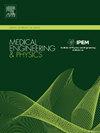Dosimetric impact of spot size variations in proton pencil beam scanning — a Monte Carlo simulation study
IF 1.7
4区 医学
Q3 ENGINEERING, BIOMEDICAL
引用次数: 0
Abstract
Background and Purpose
Spot size is a crucial parameter in the clinical operation of light-ion beam therapy delivery systems. This study aims to quantify the influence of spot size variations on dose distribution in proton pencil beam radiotherapy.
Materials and Methods
Three cubic targets with modulation widths (M) of 3 cm, 6 cm, and 9 cm were positioned at center depths (CD) of 5 cm, 15 cm, and 25 cm within a water phantom. Dosimetric evaluations including 3D γ passing rate (γ-PR), 2D point-to-point dose, lateral penumbra, and flatness, were performed using a Monte Carlo tool. Furthermore, an additional analysis was performed using 3D γ-PR to evaluate the spot size variations of three patients with varying tumor sites and volumes.
Results
With a tolerance of 2 % and 2 mm, the dose distribution changes slightly for a 10 % increase in spot size (3D γ-PR>95 %). Decreasing the spot size by 10 %, the 3D γ-PR values were no <90 %. Furthermore, as depth increases, the 3D γ-PR values tend to increase. The 2D point-to-point dose deviations remained below 3 % for spot size variations of ±10 %. Additionally, as depth increases, the 2D point-to-point dose deviations decrease. Increasing the spot size by 10 % led to a maximum change in lateral penumbra of 1.53 mm, while decreasing the spot size by 10 % resulted in lateral penumbra deviations consistently below 1 mm for all cube targets. Additionally, as depth increases, the absolute value of lateral penumbra deviations tends to decrease. With both a 10 % decrease and increase in spot size, the deviations of flatness were always lower than 3 %. And the deviations of flatness decrease as depth increases.
Conclusions
The decreasing and increasing spot size had different effects in terms of disturbing the target dose. The dosimetric impact of spot size variations was strongly correlated with target depth. Higher-energy beams showed less sensitivity to the perturbation. Thus, a higher spot size tolerance could be expected.
质子铅笔束扫描中光斑大小变化的剂量学影响——蒙特卡罗模拟研究
背景与目的光斑大小是光离子束治疗系统临床操作的关键参数。本研究旨在量化质子束放射治疗中光斑大小变化对剂量分布的影响。材料与方法将调制宽度(M)分别为3cm、6cm和9cm的3个立方体靶放置在水模体内中心深度(CD)分别为5cm、15cm和25cm的位置。使用蒙特卡罗工具进行剂量学评估,包括3D γ通过率(γ- pr), 2D点对点剂量,侧半影和平坦度。此外,使用3D γ-PR进行了额外的分析,以评估三名不同肿瘤部位和体积的患者的斑点大小变化。结果在2%和2mm的容差范围内,当光斑尺寸增加10% (3D γ-PR> 95%)时,剂量分布变化不大。光斑尺寸减小10%,3D γ-PR值减小90%。此外,随着深度的增加,三维γ-PR值有增加的趋势。当光斑大小变化为±10%时,二维点对点剂量偏差保持在3%以下。此外,随着深度的增加,二维点对点剂量偏差减小。当光斑尺寸增加10%时,侧影偏差最大可达1.53 mm,而当光斑尺寸减小10%时,侧影偏差始终小于1 mm。此外,随着深度的增加,侧影偏的绝对值有减小的趋势。当光斑尺寸减小或增大10%时,平整度偏差均小于3%。平面度偏差随深度的增加而减小。结论减小和增大光斑大小对靶剂量的干扰效果不同。斑点大小变化对剂量学的影响与目标深度密切相关。高能光束对扰动的敏感度较低。因此,可以期望更高的斑点尺寸公差。
本文章由计算机程序翻译,如有差异,请以英文原文为准。
求助全文
约1分钟内获得全文
求助全文
来源期刊

Medical Engineering & Physics
工程技术-工程:生物医学
CiteScore
4.30
自引率
4.50%
发文量
172
审稿时长
3.0 months
期刊介绍:
Medical Engineering & Physics provides a forum for the publication of the latest developments in biomedical engineering, and reflects the essential multidisciplinary nature of the subject. The journal publishes in-depth critical reviews, scientific papers and technical notes. Our focus encompasses the application of the basic principles of physics and engineering to the development of medical devices and technology, with the ultimate aim of producing improvements in the quality of health care.Topics covered include biomechanics, biomaterials, mechanobiology, rehabilitation engineering, biomedical signal processing and medical device development. Medical Engineering & Physics aims to keep both engineers and clinicians abreast of the latest applications of technology to health care.
 求助内容:
求助内容: 应助结果提醒方式:
应助结果提醒方式:


